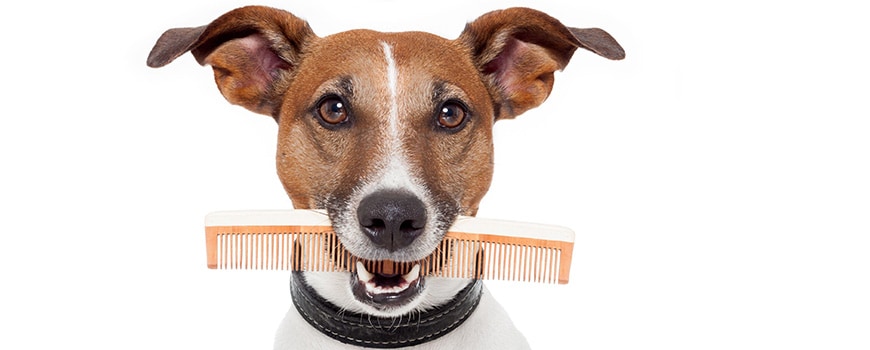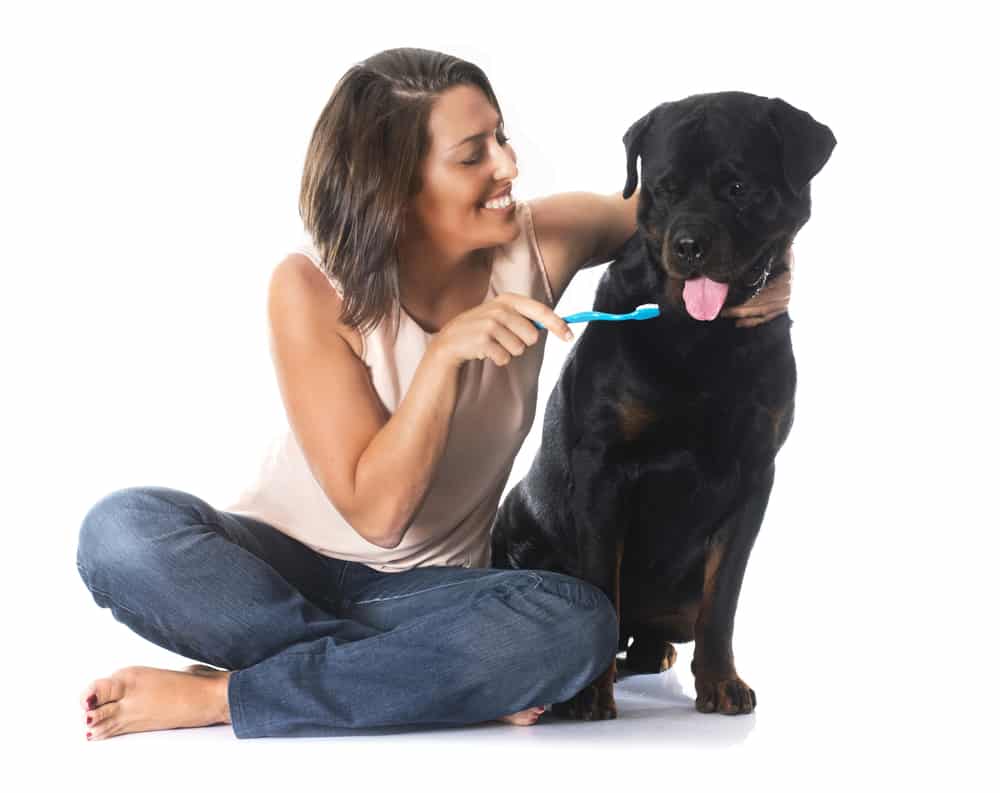To brush your Rottweiler’s teeth you will need a pet toothbrush, gauze for wrapping around a finger, or a finger toothbrush, which, as the name suggests, simply slides over your finger, and some toothpaste designed specifically for dogs. If you go with a pet toothbrush, be sure to get one specially designed for a Rottweiler or the mouth of a large-breed dog. A small toothbrush designed for, say, a Boston Terrier, will do little for your Rottweiler.
A word of caution: Do not use human toothpaste. It is not designed for dogs and can upset your dog’s stomach. Most canine toothpastes are formulated with poultry or malt-flavored enhancers for easier acceptance.
As with other aspects of grooming, it is much easier to begin introducing oral hygiene to a puppy, but it is never too late to begin. You will need to start slowly and progress at a pace suitable for your Rottweiler. Most dogs, be they young or old, will no doubt take issue with a toothbrush being jammed in their mouth, so start by using your finger to gently massage his gums.
Put a small dab of doggie toothpaste on your index finger and let your dog lick it. Praise him for being brave! Apply another dab on your finger, gently lift up his outer lips, and massage his gums.
Ideally, it is best to massage in a circular motion but, in the beginning, you may need to be satisfied with simply getting your finger in your dog’s mouth. Try to massage both top and bottom, and the front gums, too. Watch out for those sharp baby teeth, and remember to keep a positive attitude, and praise and reassure your Rottweiler throughout the process.
It is also helpful if you try to avoid wrestling with your dog or restraining him too tightly. This will only hamper the process and make him resistant to the necessary routine.
Depending on your dog, it may take a few days or a few weeks for him to accept you fiddling about in his mouth. Hopefully, he will eventually come to look forward to the routine. That is the long-term goal. It is possible he may never come to enjoy it, but it is important that he learns to accept it.
Once your dog is comfortable with this process, try using a toothbrush, finger toothbrush, or a gauze pad wrapped around your finger. Let your dog lick some toothpaste of the toothbrush or gauze pad and, again, praise him for being brave! This will help accustom him to the texture of the brush or gauze while building his confidence.
You are now ready to begin brushing. As before, lift the outer lips and expose the teeth. Most owners find it easiest to start with the canine teeth—the large ones in the front of the mouth.
They are easiest to reach, and you should be able to brush them with little interference o r objection from your dog. Once your dog is accustomed to you brushing a few teeth, progress to a few more, then a few more until you have brushed all 42 teeth (or 28 teeth if you have a puppy).
How Often to Brush the Teeth
Ideally, you should strive to brush your Rottweiler ‘s teeth on a daily basis, just as you do with your own teeth. Like anything else, the hardest part is getting started. However, once you accustom your Rottweiler to having his teeth brushed, you can incorporate it into your daily schedule.
For instance, you might try incorporating it into your nightly routine, such as before you go to bed. You can make a production of it, so that your dog views it as a fun game you do together. Ask him in a happy, excited voice, “What are we going to do now?” Or, “Is it time to brush your teeth?” When you are done brushing, praise him for being brave. “What a clever boy!”
If brushing every day seems an impossible task, try to brush your dog’s teeth every other day or at least several times a week, because bacteria generally re-establish within about 20 minutes and tartar will harden within about 1 week. If your Rottweiler refuses to cooperate despite your best efforts—take him to your veterinarian for regular cleanings.
The Importance of Dental Care
Just as you take good care of your teeth, it is essential that you take good care of your Rottweiler’s teeth. The importance of high-quality dental hygiene cannot be overstated. If left unattended, your Rottweiler can develop periodontal disease, a progressive disease that can, in advanced cases, lead to decayed gums, infection, and liver, kidney, and heart damage.
It is estimated that 80 percent of dogs over the age of 3 years have some stage of periodontal disease. And, like humans, dogs do experience painful toothaches, although some dogs may not physically exhibit signs of pain or the signs may be subtle and therefore overlooked by some owners.
Dental problems in dogs begin in the same way they do in humans—with plaque. Plaque is a colorless, transparent adhesive fluid, and it is the major culprit in periodontal disease. Plaque begins with the accumulation of food particles and bacteria along the gumline.
Germs present in plaque attack the gums, bone, and ligaments that support the teeth, and routine home care can help remove this plaque. However, when left untreated, minerals and saliva combine with the plaque and harden into a substance called tartar or calculus.
As the tartar accumulates, it starts irritating your dog’s gums and causes an inflamed condition called gingivitis, which is easily identified by the yellowish-brown crust on the teeth and the reddening of gums next to the teeth.
In the early stages, periodontal disease, which results from the buildup of plaque and tartar around and under the gumline, generally is reversible, provided your Rottweiler receives veterinary attention along with sufficient and regular brushings at home. Otherwise, the process continues to erode the tissues and bones that support the teeth, which can lead to pain and tooth loss. As bad as that sounds, it can get worse.
If the tartar is not removed, the cycle continues to repeat itself, encouraging even more bacterial growth. The tartar builds up under the gums and causes the gums to separate from the teeth; this causes even larger pockets in which more debris can collect.
At this stage, your Rottweiler’s teeth no doubt have quite an accumulation of highly visible, crusty, yellowish-brown tartar. Brushing your Rottweiler’s teeth on a regular basis will remove plaque but not tartar. If your precious pooch already has a tartar build up, he will need to see a veterinarian to have it removed and his teeth polished.
In most advanced stages, damage from periodontal disease is considered irreversible because bacterial infection has been busy destroying your Rottweiler’s gums, teeth, and bones. In addition, bacteria can also enter the bloodstream, causing secondary infections that can damage your dog’s heart, liver, and kidneys.
In addition to home-care, a good dental hygiene program includes an annual veterinary exam. A veterinarian will check for potential problems, such as plaque and tartar build-up, gingivitis, periodontal disease, and fractured or abscessed teeth. If necessary, a veterinarian may recommend professional dental cleaning, also known as prophylaxis or prophy.
While anesthetized, a dog’s mouth is flushed with a solution to kill bacteria, the teeth are cleaned to remove any tartar, polished, inspected, and flushed again with an antibacterial solution, and fluoride is applied. Fractured teeth may require reconstructive surgery not unlike people receive, such as root canals and crowns.
The best way to prevent periodontal disease is to keep your Rottweiler’s teeth clean. The process is relatively simple and requires nothing more than a small number of fairly inexpensive supplies and a few minutes of your time.
Chews and Food for Dental Hygiene
Chew Toys: You can try sing any number of chew/dental toys available for dogs that help to remove plaque. Select products that are right for the chewing style of your Rottweiler, and that are made to last. Toys should not replace brushing, but they will help to remove some of the plaque, exercise your Rottweiler’s jaw, and satisfy his need to chew.
Be sure to keep an eye on the toys and toss them when they get too small and become possible choking hazards. Be sure to avoid toys and bones that are hard enough to crack or break an aggressive chewer’s teeth.
Food: Many veterinarians recommend avoiding table scraps and sweet treats, because they can increase the build-up of plaque. A high-quality, crunchy dog food may help to keep plaque from accumulating on teeth; however, this topic is highly debatable among the experts.
Either way, a dry, crunchy food is most definitely better for exercising your dog’s jaw. Veterinary dentist—approved dog food is available that is designed to help reduce plaque and tartar build-up. Your veterinarian can provide information on these products.
Doggie Bad Breath
Also known as halitosis, bad breath is generally indicative of something more serious, such as periodontal disease, diabetes, kidney disease, or gastrointestinal problems. Unless you have seen your precious pooch eat something particularly offensive like spoiled garbage, squirrel guts, cat stools, or another dog’s stools (or even his own stools)—yes, some dogs find this appetizing—it is best to have your dog examined by a veterinarian. If left untreated, some causes of bad breath can be indicative of severe and even fatal complications.

